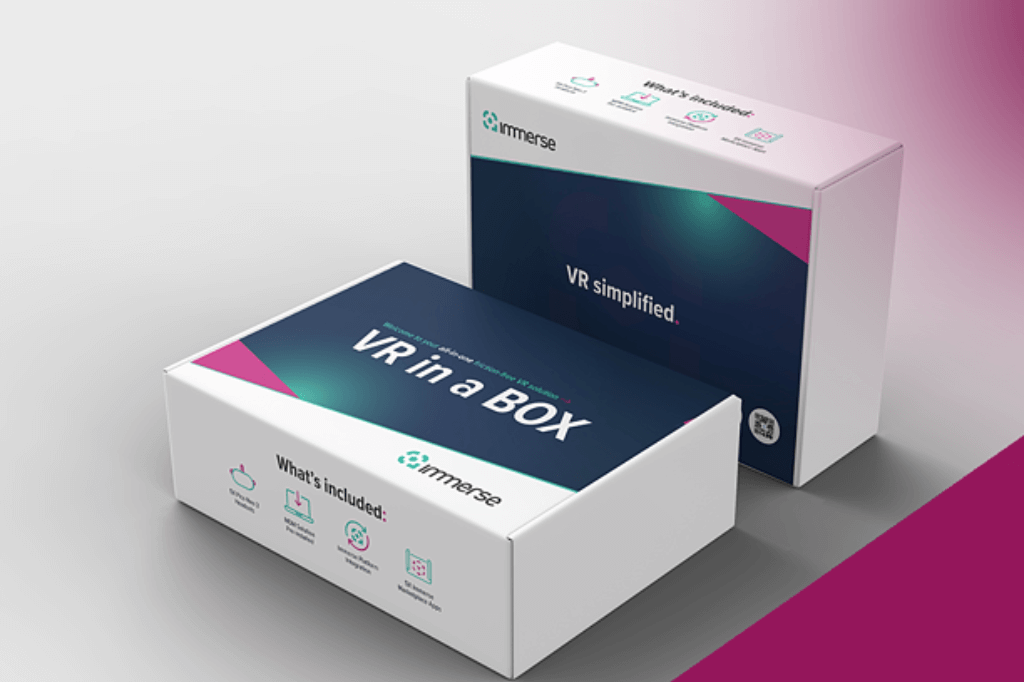Immerse just put out its latest product, VR in a BOX. The platform provider for virtual reality training knows that enterprise VR has a steep learning curve for many. According to the company, VR in a BOX is a compact, frictionless solution for enterprises that want to start using VR. It streamlines enterprise XR training programs.
Streamlined VR Training
VR training has made an enormous difference in the scope of enterprise training. Most industries can benefit from adopting virtual reality as a training solution.
VR training can teach, upskill, and reskill the local and remote workforce. However, many businesses struggle to adopt and implement VR training. Immerse identified the major hurdles to VR adoption: software, hardware, and affordability.
Immerse created VR in a BOX with enterprises in mind. Large organizations can use the product even without prior VR experience. It provides every tool necessary to run Immerse’s open and scalable platform. It also includes all software components to implement XR initiatives across the enterprise.
Heath Shatouhy, Immerse’s CCO, stated that their goal is to make VR accessible to businesses and provide “immediate benefits.” Over the years, they have seen how VR overwhelms enterprises – they either don’t know where to start or fail to adopt the technology. VR in a BOX tackles these difficulties.
“After over 10 years in the industry, we realized companies often felt overwhelmed by the adoption process and didn’t know where to start,” said Shatouhy in a press release shared with ARPost. “Our VR in a BOX solution addresses this issue and provides an easy-to-understand solution for CIOs, CLOs, HR leaders, and their teams to help them implement Immerse’s truly open, scalable platform.”
Conventional training that typically takes months is cut down to mere weeks. This helps enterprises to speed up the adoption and delivery of their VR initiatives. VR in a BOX provides a more immersive, engaging, and safe training experience, compared to traditional training tools.
VR in a BOX: All-in-One and Friction-Free
Available since September 13, VR in a BOX enables companies to focus on variables that matter. Businesses can use the product to provide employees with unique immersive content, and can also track and measure its impact. Customers of SAP can also link their platforms to SuccessFactors.
VR in a BOX includes access to Immerse Platform, five Immerse Marketplace learning applications, pre-installed Mobile Device Management (MDM) solution, and five Pico Neo 3 headsets.
Access to Immerse Platform
The Immerse Platform is a content aggregation, dissemination, and reporting tool. It helps companies develop, deploy, scale, and assess VR training solutions. Major corporations such as DHL, Shell, and GE Healthcare have adopted the platform.
VR in a BOX includes a year of platform access. This allows enterprises to collect performance data from the onset. The platform also features a selection of distribution options along with app-level reporting.

5 Immerse Marketplace App Choices
The Immerse Marketplace is an all-in-one hub for immersive training resources. It offers over 120 VR and desktop apps and covers a wide range of topics. These include health and safety, people skills, hazard awareness, and career development. The marketplace also features reporting and analytics. Organizations may choose a bundle from a specific industry, or select the apps separately.
Pre-Installed MDM Solution
MDM software oversees and secures devices, apps, and data from a single console. It helps companies manage mobile grids remotely without disrupting the end-user experience. The box has a pre-installed MDM solution to help organizations regulate content in the future.
5 Pico Neo 3 Headsets
Pico Neo 3 is a sophisticated, wireless VR headset designed for businesses. It has all the necessary features for scale-ups without needing demanding commercial conditions.
VR in a BOX provides five Neo 3 headsets stacked with features. These include room-scale tracking, high-quality FOV, and built-in spatial stereo speakers.
This article was originally published on arpost
